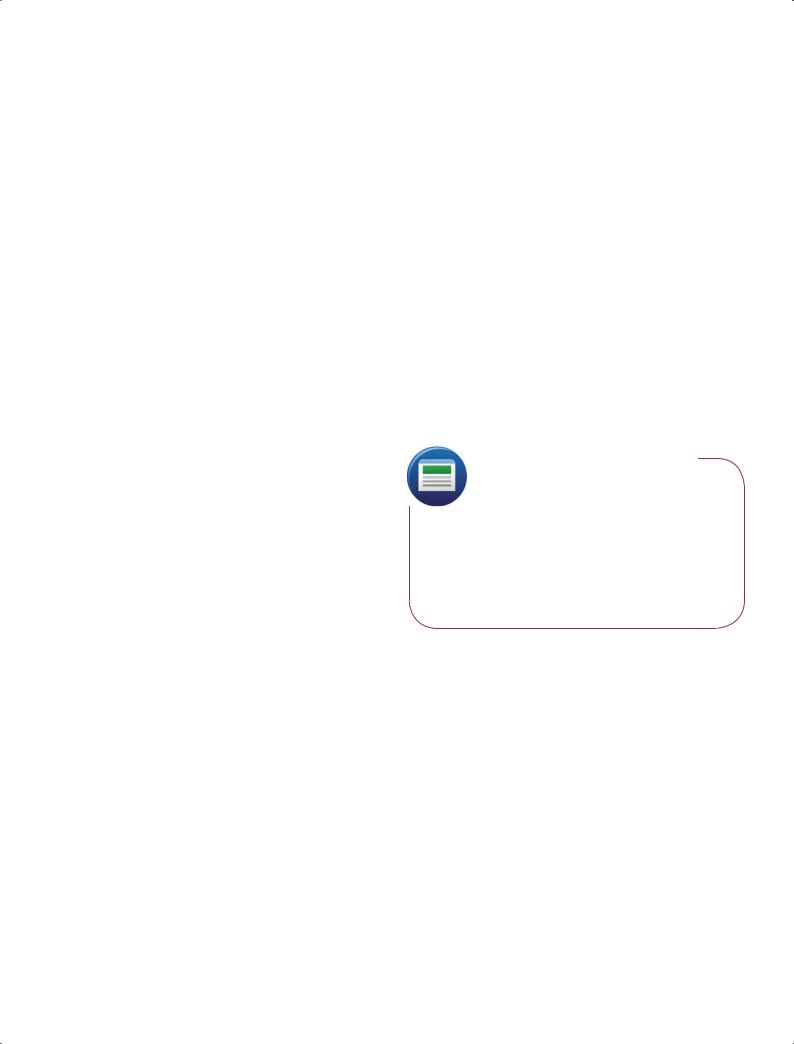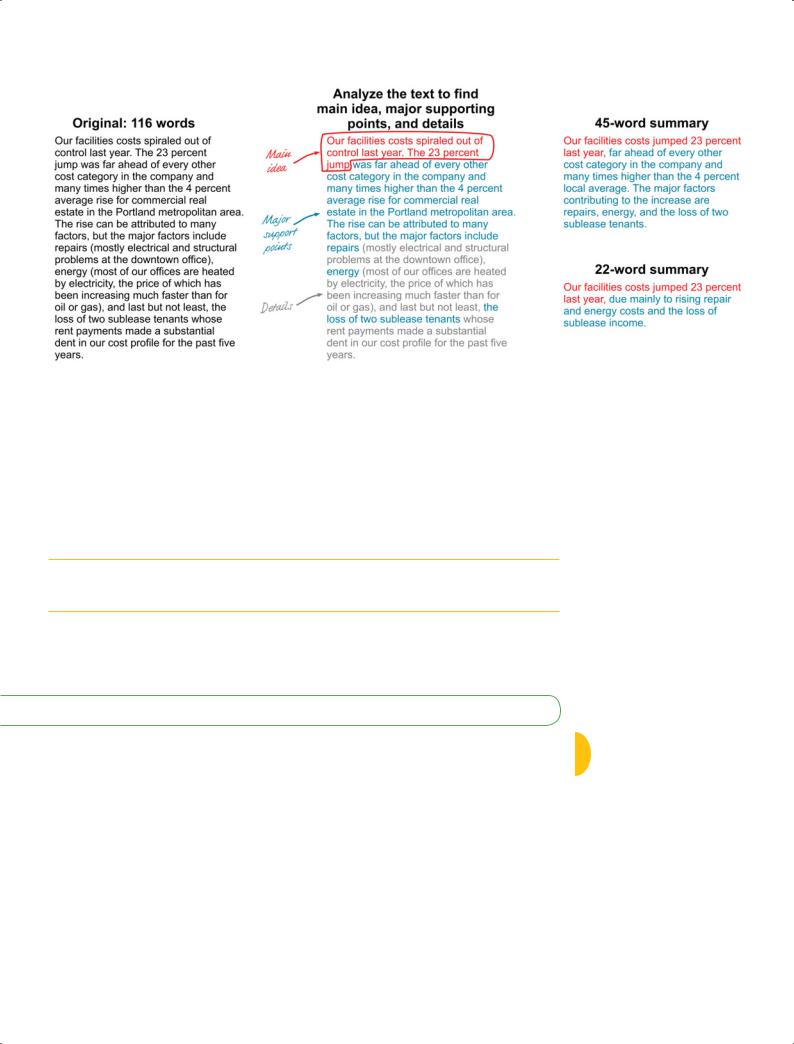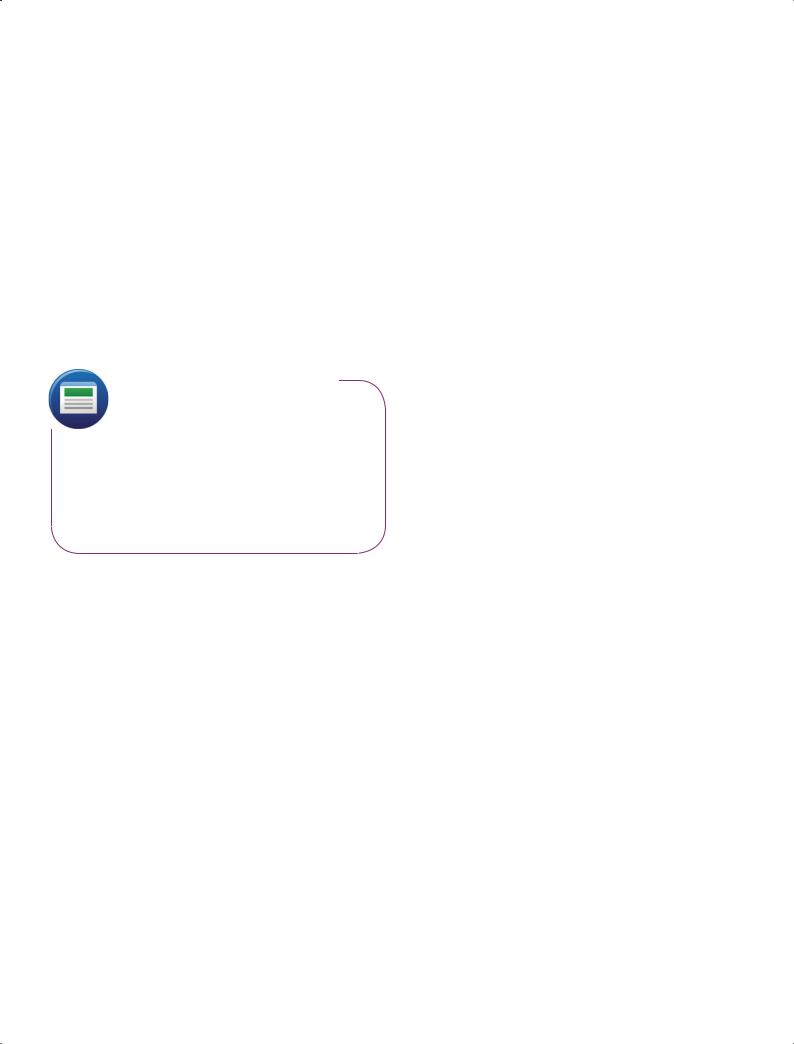
- •Understanding Why Communication Matters
- •Communicating as a Professional
- •Exploring the Communication Process
- •Committing to Ethical Communication
- •Communicating in a World of Diversity
- •Using Technology to Improve Business Communication
- •Chapter Review and Activities
- •Test Your Knowledge
- •Apply Your Knowledge
- •Practice Your Skills
- •Expand Your Skills
- •References
- •Understanding the Three-Step Writing Process
- •Analyzing the Situation
- •Gathering Information
- •Selecting the Right Medium
- •Organizing Your Message
- •Chapter Review and Activities
- •Test Your Knowledge
- •Apply Your Knowledge
- •Practice Your Skills
- •Expand Your Skills
- •References
- •Adapting to Your Audience: Building Strong Relationships
- •Adapting to Your Audience: Controlling Your Style and Tone
- •Composing Your Message: Choosing Powerful Words
- •Composing Your Message: Creating Effective Sentences
- •Composing Your Message: Crafting Coherent Paragraphs
- •Using Technology to Compose and Shape Your Messages
- •Chapter Review and Activities
- •Test Your Knowledge
- •Apply Your Knowledge
- •Practice Your Skills
- •Expand Your Skills
- •References
- •Revising Your Message: Evaluating the First Draft
- •Revising to Improve Readability
- •Editing for Clarity and Conciseness
- •Using Technology to Revise Your Message
- •Producing Your Message
- •Proofreading Your Message
- •Distributing Your Message
- •Chapter Review and Activities
- •Test Your Knowledge
- •Apply Your Knowledge
- •Practice Your Skills
- •Expand Your Skills
- •References
- •Electronic Media for Business Communication
- •Social Networks
- •Information and Media Sharing Sites
- •Instant Messaging and Text Messaging
- •Blogging
- •Podcasting
- •Chapter Review and Activities
- •Test Your Knowledge
- •Apply Your Knowledge
- •Practice Your Skills
- •Expand Your Skills
- •References
- •Strategy for Routine Requests
- •Common Examples of Routine Requests
- •Strategy for Routine Replies and Positive Messages
- •Common Examples of Routine Replies and Positive Messages
- •Chapter Review and Activities
- •Test Your Knowledge
- •Apply Your Knowledge
- •Practice Your Skills
- •Expand Your Skills
- •References
- •Using the Three-Step Writing Process for Negative Messages
- •Using the Direct Approach for Negative Messages
- •Using the Indirect Approach for Negative Messages
- •Sending Negative Messages on Routine Business Matters
- •Sending Negative Employment Messages
- •Sending Negative Organizational News
- •Responding to Negative Information in a Social Media Environment
- •Chapter Review and Activities
- •Test Your Knowledge
- •Apply Your Knowledge
- •Practice Your Skills
- •Expand Your Skills
- •References
- •Using the Three-Step Writing Process for Persuasive Messages
- •Developing Persuasive Business Messages
- •Common Examples of Persuasive Business Messages
- •Developing Marketing and Sales Messages
- •Chapter Review and Activities
- •Test Your Knowledge
- •Apply Your Knowledge
- •Practice Your Skills
- •Expand Your Skills
- •References
- •Applying the Three-Step Writing Process to Reports and Proposals
- •Supporting Your Messages with Reliable Information
- •Conducting Secondary Research
- •Conducting Primary Research
- •Planning Informational Reports
- •Planning Analytical Reports
- •Planning Proposals
- •Chapter Review and Activities
- •Test Your Knowledge
- •Apply Your Knowledge
- •Practice Your Skills
- •Expand Your Skills
- •References
- •Writing Reports and Proposals
- •Writing for Websites and Wikis
- •Illustrating Your Reports with Effective Visuals
- •Completing Reports and Proposals
- •Chapter Review and Activities
- •Test Your Knowledge
- •Apply Your Knowledge
- •Practice Your Skills
- •Expand Your Skills
- •References
- •Finding the Ideal Opportunity in Today’s Job Market
- •Planning Your Résumé
- •Writing Your Résumé
- •Completing Your Résumé
- •Chapter Review and Activities
- •Test Your Knowledge
- •Apply Your Knowledge
- •Practice Your Skills
- •Expand Your Skills
- •References
- •Submitting Your Résumé
- •Understanding the Interviewing Process
- •Preparing for a Job Interview
- •Interviewing for Success
- •Following Up After an Interview
- •Chapter Review and Activities
- •Test Your Knowledge
- •Apply Your Knowledge
- •Practice Your Skills
- •Expand Your Skills
- •References
- •Index

252 Unit 4: Longer Business Messages
DIRECT APPROACH
Since the company’s founding 25 years ago, we have provided regular repair service for all our electric appliances.This service has been an important selling point as well as a source of pride for our employees. However, rising labor costs have made it impossible to maintain
repair service for all our electric appliances.This service has been an important selling point as well as a source of pride for our employees. However, rising labor costs have made it impossible to maintain
profitability while offering competitive service rates. Last year, we lost $500,000 on our repair business. 
Because of your concern over these losses, you asked me to study whether we should discontinue our repair service.After analyzing the situation in depth, I have concluded that the repair service is an  expensive, impractical tradition, and I recommend that the service be discontinued.
expensive, impractical tradition, and I recommend that the service be discontinued.
By withdrawing from the electric appliance repair business, we can substantially improve our financial performance without damaging our reputation with customers.This conclusion is based on three basic points that are covered in the following pages:
ss)T ISTHIGHLy unlikely that we will ever be able to make a profit in the repair business.
ssWe can refer customers to a variety of qualified repair firms without significantly reducing customer satisfaction.
ss#LOSINGODOWN THE SERvice operation will create few internal problems.
Summarizes the situation
Immediately introduces one of the report’s major conclusions
Reminds the audience why the report was prepared
Presents the report’s key recommendation, that the repair service should be discontinued
Emphasizes the benefits of acting on the recommendation and addresses any fears about possible negative consequences
Lists three important conclusions that led to the recommendation to end the service (notice how the indirect approach that follows presents these same three points as questions to be considered)
|
|
|
|
|
|
|
|
INDIRECT APPROACH |
|
|
|
|
|
|
|
|
|
|
|
|
|
|
|
|
|
|
|
|
|
Summarizes the situation |
|
|
|
|
|
Since the company’s founding 25 years ago, we have provided regular |
|
||
|
|
|
|
|
|
||||
|
|
|
|
|
|
|
|
repair service for all our electric appliances.This service has been an |
|
|
|
|
|
|
|
|
|
important selling point as well as a source of pride for our employees. |
|
|
|
|
|
|
|
|
|
However, rising labor costs have made it impossible to maintain |
|
|
|
|
|
|
|
|
|
profitability while offering competitive service rates. |
|
|
|
|
|
|
|
|
|
Because of your concern over these losses, you have asked me to |
|
Reminds the audience why the report |
|
|
study whether we should discontinue our repair service. I have |
|
|||||
|
|
|
|||||||
was prepared |
|
analyzed the situation in depth, and the following pages present my |
|
||||||
|
|
|
|
|
|
|
|
findings and recommendations for your review. The analysis |
|
Indicates that conclusions and |
|
|
|
addressed three basic questions: |
|
||||
|
|
|
|
||||||
recommendations will be presented |
|
ssWhat is the extent of our losses, and what can we do to turn the |
|
||||||
later in the report |
|
business around? |
|
||||||
Introduces the three points that will |
|
|
|
ssWould withdrawal hurt our sales of electrical appliances? |
|
||||
|
|
ssWhat would be the internal repercussions of closing down the |
|
||||||
|
|
|
|||||||
eventually lead to the conclusions and |
|
|
|||||||
|
repair business? |
|
|||||||
ultimately to the recommendation |
|
|
|
||||||
|
|
|
|
|
|
|
|
|
|
|
|
|
|
|
|
|
|
|
|
Figure 10.3 Direct Approach Versus Indirect Approach in an Introduction
In the direct version of this introduction, the writer quickly presents the report’s recommendation, followed by the conclusions that led to that recommendation. In the indirect version, the same topics are introduced in the same order, but no conclusions are drawn about them; the conclusions and the ultimate recommendation appear later, in the body of the report.
2 LEARNING OBJECTIVE
Describe an effective process for conducting business research, explain how to evaluate the credibility of an information source, and identify the five ways to use research results.
Researching without a plan wastes time and usually produces unsatisfactory results.
Supporting Your Messages with Reliable Information
Effective research involves a lot more than simply typing a few terms into a search engine. Save time and get better results by using a clear process:
1.Plan your research. Planning is the most important step of any research project; a solid plan yields better results in less time.
2.Locate the data and information you need. Your next step is to figure out where the data and information are and how to access them.
3.Process the data and information you located. The data and information you find probably won’t be in a form you can use immediately and may require statistical analysis or other processing.
4.Apply your findings. You can apply your research findings in three ways: summarizing information, drawing conclusions, and developing recommendations.
5.Manage information efficiently. Many companies are trying to maximize the return on the time and money invested in business research by collecting and sharing research results in a variety of computer-based systems, known generally as knowledge management systems.

Chapter 10: Understanding and Planning Reports and Proposals |
253 |
Planning Your Research
Start by developing a problem statement that defines the purpose of your research—the decision you need to make or the conclusion you need to reach at the end of the process. Next, identify the information you need to make that decision or reach that conclusion. You can then begin to generate the questions that will constitute your research. Chances are you will have more questions than you have time or money to answer, so prioritize your information needs.
Before beginning any research project, remember that research carries some significant ethical responsibilities. Your research tactics affect the people you gather data and information from, the people who read your results, and the people who are affected by the way you present those results. To avoid ethical lapses, follow these guidelines:
■Keep an open mind so that you don’t skew the research toward answers you want or expect to see.
■Respect the privacy of your research participants, and don’t mislead people about the purposes of your research.2
■Document sources and give appropriate credit.
■Respect your sources’ intellectual property rights (the ownership of unique ideas that have commercial value in the marketplace).3
■Don’t distort information from your sources.
■Don’t misrepresent who you are or what you intend to do with the research results.
In addition to ethics, research etiquette deserves careful attention. For example, respect the time of anyone who agrees to be interviewed or to be a research participant, and maintain courtesy throughout the interview or research process.
The problem statement guides your research by focusing on the decision you need to make or the conclusion you need to reach.
Locating Data and Information
The range of sources available to business researchers today can be overwhelming. The good news is that if you have a question about an industry, a company, a market, a new technology, or a financial topic, somebody else has probably already researched the subject. Research done previously for another purpose is considered secondary research; sources for such research information include magazines, news-
papers, public websites, books, and other reports. Don’t let the name secondary fool you, though. You want to start with secondary research because it can save you considerable time and money for many projects. In contrast, primary research involves the collection of new data through surveys, interviews, and other techniques.
Primary research provides information that you gather specifically for a new research project; secondary research consists of information that others have gathered (and published,
in many cases).
Evaluating Information Sources
No matter where you’re searching, it is your responsibility to separate quality information from unreliable junk, so you don’t taint your results or damage your reputation. Social media tools have complicated this challenge by making many new sources of information available. On the positive side, independent sources communicating through blogs, Twitter and other microblogging sites, wikis, user-generated content sites, and podcasting channels can provide valuable and unique insights, often from experts whose voices might never be heard otherwise. On the negative side, these nontraditional information sources often lack the editorial boards and fact checkers commonly used in traditional publishing. You cannot assume that the information you find in blogs and other sources is accurate, objective, and current. Answer the following questions about each piece of material:
■Does the source have a reputation for honesty and reliability? For example, try to find out how the source accepts articles and whether it has an editorial board, conducts peer reviews, or follows fact-checking procedures.
■Is the source potentially biased? To interpret an organization’s information, you need to know its point of view.
Evaluate your sources carefully to avoid embarrassing and potentially damaging mistakes.

254 Unit 4: Longer Business Messages
|
REAL-TIME UPDATES |
|
■ |
What is the purpose of the material? For instance, was |
|
Learn More by Watching This Video |
|
|
the material designed to inform others of new research, to |
|
|
|
advance a political position, or to promote a product? |
|
|
|
|
|
|
|
|
quality |
|
Is the author credible? Is the author a professional jour- |
|
Quick tips for evaluating the research |
■ |
||
|
of a website |
|
nalist or merely someone with an opinion? |
|
|
This short video from the Monterey Public Library |
■ |
Where did the source get its information? Try to find out |
|
will help you determine how much trust to put in websites you |
|
who collected the data and the methods used. |
||
use for research. Go to http://real-timeupdates.com/bce6 and |
■ |
Can you verify the material independently? Verification |
||
click on Learn More. If you are using MyBCommLab, you can |
|
is particularly important when the information goes be- |
||
access Real-Time Updates within each chapter or under Student |
|
yond simple facts to include projections, interpretations, |
||
Study Tools. |
|
and estimates. |
||
|
|
|
■ |
Is the material current and complete? Make sure you are |
|
|
|
|
using the most current information available. Have you |
|
|
|
|
accessed the entire document or only a selection from it? |
■Does the information make sense? Step back and determine whether the information stands up to logical scrutiny.
You probably won’t have time to conduct a thorough background check on all your sources, so focus your efforts on the most important or most suspicious pieces of information. And if you can’t verify critical facts or figures, be sure to let your readers know that.
After you collect data and information, the next step is converting it into usable content.
Quoting a source means reproducing the content exactly and indicating who created the information originally.
Paraphrasing is expressing someone else’s ideas in your own words.
Summarizing is similar to paraphrasing but distills the content into fewer words.
Using Your Research Results
After you’ve collected your data and information, the next step is to transform this raw material into the specific content you need. This step can involve quoting, paraphrasing, or summarizing textual material; drawing conclusions; and making recommendations.
Quoting, Paraphrasing, and Summarizing Information
You can use textual information from secondary sources in three ways. Quoting a source means you reproduce the material exactly as you found it (giving full credit to the source, of course). Use direct quotations when the original language will enhance your argument or when rewording the passage would reduce its impact. However, be careful with direct quotes: Using too many creates a choppy patchwork of varying styles and gives the impression that all you’ve done is piece together the work of other people. When quoting sources, set off shorter passages with quotation marks and set off longer passages (generally, five lines or more) as separate, indented paragraphs.
You can often maximize the impact of secondary material in your own writing by paraphrasing it: restating it in your own words and with your own sentence structures.4 Paraphrasing helps you maintain consistent tone while using vocabulary that’s familiar to your audience. Of course, you still need to credit the originator of the information, but you don’t need quotation marks or indented paragraphs.
Summarizing is similar to paraphrasing but presents the gist of the material in fewer words than the original by leaving out details, examples, and less important information (see Figure 10.4). Like quotations and paraphrases, summaries also require complete documentation of sources. Summarizing is not always a simple task, and your audience will judge your ability to separate significant issues from less significant details.
Of course, all three approaches require careful attention to ethics. When quoting directly, take care not to distort the original intent of the material by quoting selectively or out of context. And never resort to plagiarism—presenting someone else’s words as your own, such as copying material from an online source and dropping it into a report without giving proper credit.
Drawing Conclusions
A conclusion is a logical interpretation of facts and other information. In addition to being logically sound, a conclusion should be based only on the information provided or at least referred to in the report. Reaching good conclusions is one of the most important skills you can develop in your business career. In fact, the ability to see patterns and possibilities that others can’t is one of the hallmarks of innovative business leaders.

Chapter 10: Understanding and Planning Reports and Proposals |
255 |
Figure 10.4 Summarizing Effectively
To summarize a section of text, first analyze it to find the main idea, the major support points, and the lessimportant details. Then assemble the appropriate pieces with additional words and phrases as needed to ensure a smooth flow.
Making Recommendations
Whereas a conclusion interprets information, a recommendation suggests what to do about the information. The following example shows the difference between a conclusion and a recommendation:
Conclusion |
Recommendation |
On the basis of its track record and current price, I believe that this company is an attractive buy.
I recommend that we offer to buy the company at a 10 percent premium over the current market value of its stock.
To be credible, recommendations must be practical and based on sound logical analysis. Also, when making a recommendation, be certain you have adequately described the recommended course of action so that readers aren’t left wondering what happens next.
Conducting Secondary Research
Even if you intend to eventually conduct primary research, start with a review of any available secondary research. Inside your company, you might be able to find a variety of helpful reports and other documents. Outside the company, business researchers can choose from a wide range of print and online resources, both in libraries and online.
Finding Information at a Library
Public, corporate, and university libraries offer printed sources with information that is not available online and online sources that are available only by subscription. Libraries are also where you’ll find one of your most important resources: librarians. Reference librarians are trained in research techniques and can often help you find obscure information you can’t find on your own. They can also direct you to the typical library’s many sources of business information:
■Newspapers and periodicals. Libraries offer access to a wide variety of popular magazines, general business magazines, trade journals (which provide information about specific professions and industries), and academic journals (which provide researchoriented articles from researchers and educators).
3 LEARNING OBJECTIVE
Explain the role of secondary research, and describe the two major categories of online research tools.
You’ll want to start most research projects by conducting secondary research first.
Libraries offer information and resources you can’t find anywhere else—including experienced research librarians.

256Unit 4: Longer Business Messages
■Business books. Although less timely than newspapers, periodicals, and online sources, business books provide in-depth coverage and analysis that often can’t be found anywhere else.
■Directories. Thousands of directories are published in print and electronic formats in the United States, and many include membership information for all kinds of professions, industries, and special-interest groups.
■Almanacs and statistical resources. Almanacs are handy guides to factual and statistical information about countries, politics, the labor force, and so on. One of the most extensive is the Statistical Abstract of the United States (available at www.census.gov).
Local, state, and federal government agencies publish a huge array of information that is helpful to business researchers.
■Government publications. Information on laws, court decisions, tax questions, regulatory issues, and other governmental concerns can often be found in collections of government documents.
■Electronic databases. Databases offer vast collections of computer-searchable information, often in specific areas such as business, law, science, technology, and education. Some of these are available only by institutional subscription, so the library may be your only way to gain access to them. Some libraries offer remote online access to some or all databases; for others, you’ll need to visit in person.
Internet research tools fall into two basic categories: search tools and monitoring tools.
General-purpose search engines are tremendously powerful tools, but they have several shortcomings you need to consider.
Web directories rely on human editors to evaluate and select websites in various subject categories.
Online databases and specialty search engines can help you access parts of the hidden Internet.
The tools available for monitoring for new information from online sources can help you track industry trends, consumer sentiment, and other information.
Finding Information Online
The Internet can be a tremendous source of business information, provided you know where to look and how to use the tools available. Roughly speaking, the tools fall into two categories: those you can use to actively search for existing information and those you can use to monitor selected sources for new information. (Some tools can perform both functions.)
Online Search Tools
The most familiar search tools are general-purpose search engines, such as Google and Bing, which scan millions of websites to identify individual webpages that contain a specific
word or phrase and then attempt to rank the results from most useful to least useful. Website owners use search engine optimization techniques to help boost their rankings in the results, but the ranking algorithms are kept secret to prevent unfair manipulation of the results.
For all their ease and power, conventional search engines have three primary shortcomings: (1) no human editors are involved to evaluate the quality or ranking of the search results; (2) various engines use different search techniques, so they often find different material; and (3) search engines can’t reach all the content on some websites (this part of the Internet is sometimes called the hidden Internet or the deep Internet).
A variety of tools are available to overcome these weaknesses of general-purpose search engines, and you should consider one or more of them in your business research. First, web directories, such as the Open Directory Project at www.dmoz.org, use human editors to categorize and evaluate websites. A variety of other directories focus on specific media types, such as blogs or podcasts.
Second, metacrawlers or metasearch engines (such as Bovée and Thill’s Web Search, at http://websearch.businesscommunicationnetwork.com) help overcome the differences among search engines by formatting your search request for multiple search engines, making it easy to find a broader range of results. With a few clicks, you can compare results from multiple search engines to make sure you are getting a broad view of the material.
Third, online databases help address the challenge of the hidden Internet by offering access to newspapers, magazines, journals, electronic copies of books, and other resources often not available with standard search engines. Some of these databases offer free access to the public, but others require a subscription (check with your library). Also, a variety of specialized search engines now exist to reach various parts of the hidden Internet.
Online Monitoring Tools
One of the most powerful aspects of online research is the ability to automatically monitor selected sources for new information. The possibilities include subscribing to newsfeeds

from blogs, following people on Twitter and other microblogs, setting up alerts on search engines and online databases, and using specialized monitors such as TweetBeep (http:// tweetbeep.com) and TweetDeck (www.tweetdeck.com) to track tweets that mention specific companies or other terms.
Search Tips
Search engines, web directories, and databases work in different ways, so make sure you understand how to optimize your search and interpret the results for each tool you’re using. With a keyword search, the engine or database attempts to find items that include all the words you enter. A Boolean search lets you define a query with greater precision, using
such operators as AND (the search must include two terms linked by AND), OR (it can include either or both words), or NOT (the search ignores items with whatever word comes after NOT). Natural language searches let you ask questions in everyday English. Forms-based searches help you create powerful queries by simply filling out an online form.5
To make the best use of any search tool, keep the following points in mind:
■Think before you search. The neatly organized results you get from a search engine can create the illusion that the Internet is an orderly warehouse of all the information in the universe, but the reality is far different. The Internet is an incomplete, unorganized hodge-podge of millions of independent websites with information that ranges in value from priceless to utter rubbish. After you have identified what you need to know, spend a few moments thinking about where that information might be found, how it might be structured, and what terms various websites might use to describe it.
■Read the instructions and pay attention to the details. A few minutes of learning can save hours of inefficient search time.
■Review the search and display options carefully so you don’t misinterpret the results; some of these settings can make a huge difference in the results you see.
■Try variations of your terms, such as adolescent and teenager or management and managerial.
■User fewer search terms to find more results; use more search terms to find fewer results.
■Look beyond the first page of results. Don’t assume that the highest-ranking results are the best sources for you. For example, materials that haven’t been optimized for search engines won’t rank as highly (meaning they won’t show up in the first few pages of results), but they may be far better for your purposes.
Search technologies continue to evolve rapidly, so look for new ways to find the information you need. Some new tools search specific areas of information (such as Twitter) in better ways, whereas others approach search in new ways. For instance, Yolink (www.yolink
.com) finds webpages like a regular search engine does but then also searches through documents and webpages that are linked to those first-level results.6
Other powerful search tools include desktop search engines that search all the files on your personal computer, enterprise search engines that search all the computers on a company’s network, research and content managers such as the free Zotero browser extension (www.zotero.com), social tagging or bookmarking sites such as Reddit (www.reddit.com), and media curation sites such as Pinterest (http://pinterest.com).
For information on the latest online research tools and techniques, visit http://realtimeupdates.com/bce6 and click on Chapter 10.
257
Search tools work in different ways, and you can get unpredictable results if you don’t know how each one operates.
Documenting Your Sources
Documenting your sources serves three important functions: It properly and ethically credits the person who created the original material, it shows your audience that you have sufficient support for your message, and it helps readers explore your topic in more detail, if desired. Be sure to take advantage of the source documentation tools in your software, such as automatic endnote or footnote tracking.
Proper documentation of the sources you use is both ethical and an important resource for your readers.
